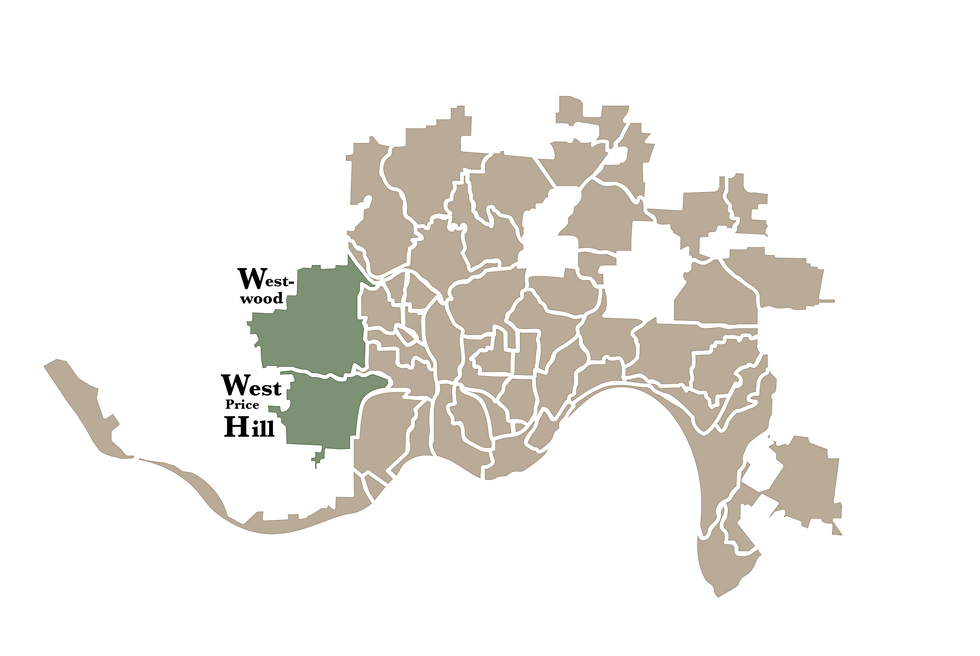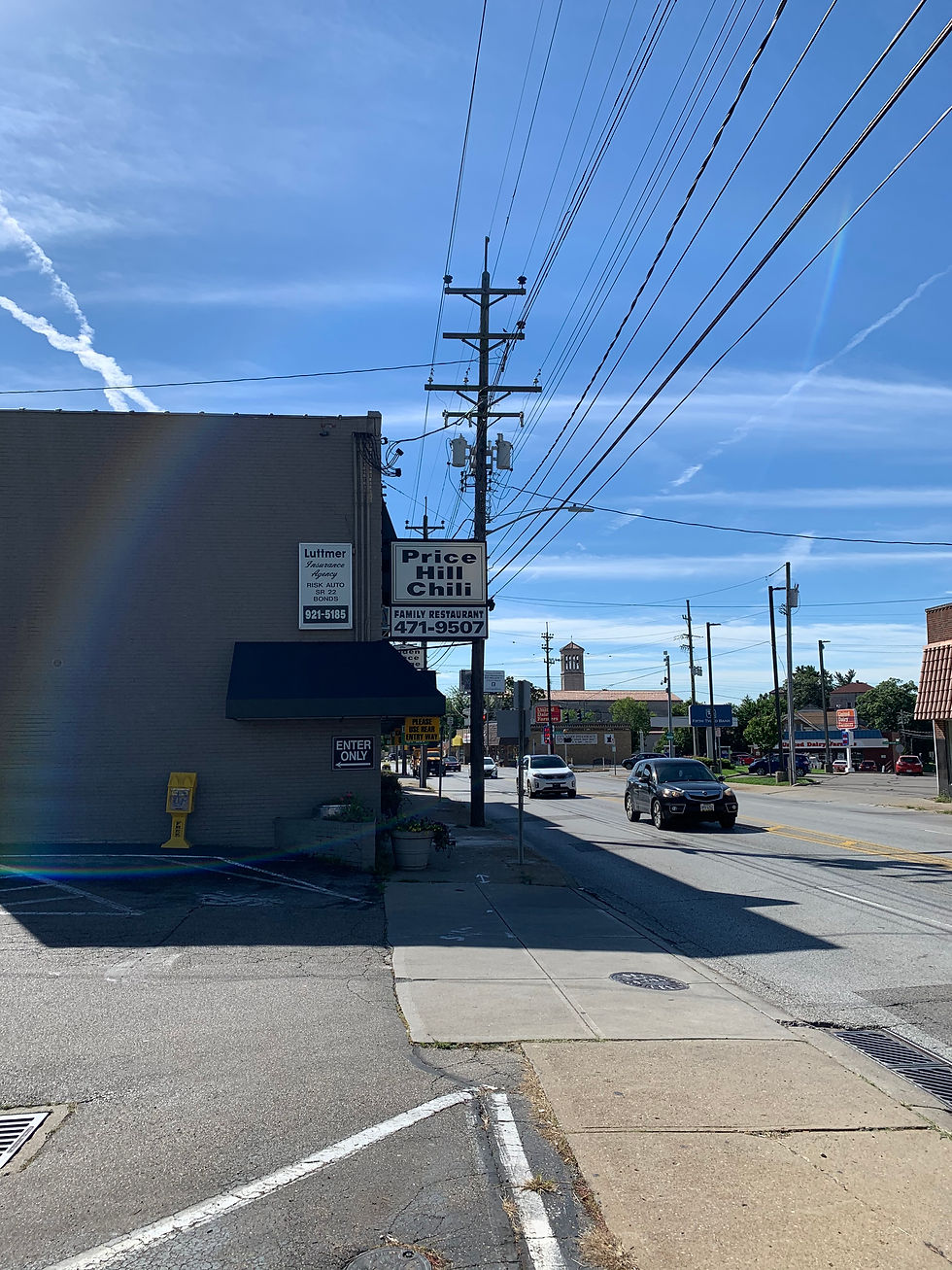West Price Hill and Westwood: Cincinnati's 2 Largest Neighborhoods
- Anthony Gustely

- Sep 12, 2020
- 6 min read

It's week 2 of exploring Cincinnati and I'm still riding the high of my successful visit to Sayler Park and Riverside last week. We're beginning to venture into the heart of the West Side of Cincinnati: a community filled with a rich history (both literally and figuratively). Sitting at 45,000 combined residents (over 15% of Cincinnati's population), West Price Hill and Westwood happen to be the two largest neighborhoods in Cincinnati. Needless to say, I had a lot of ground to cover this week, so I took my friends Emma and Ryan along for the ride.
West Price Hill

West Price Hill is one of three neighborhoods that make up the Price Hill area. Originally settled in 1791 under the name Bold Face Hill, early settlers constructed large estates on the plentiful land. Price Hill was named after General Rees E. Price, who invested in land in Price Hill and built a brickyard, sawmill, and subdivision. His sons spearheaded the construction of the Price Hill Incline (located in East Price Hill), which became a crucial mode of transportation for residents to and from downtown Cincinnati.

By the mid-19th century, Price Hill was home to many wealthy and prominent figures in Cincinnati. Conveniently positioned above the bustle, pollution, and poor living conditions of an industrialized downtown, Price Hill was lush and manicured neighborhood. The suburb became all the more lively following the completion of Cincinnati's streetcar system in 1893. Within West Price Hill, one streetcar route ran along Warsaw Avenue and ended at Glenway Avenue, while another ran east/west along West 8th Avenue. Click here to learn more about the history of Price Hill.
The first stop of the day was Price Hill Chili - a legendary restaurant that's been serving up traditional Cincinnati chili since 1962. Located on Glenway Avenue, which snakes through the center of West Price Hill, Price Hill Chili is open for breakfast, lunch, and dinner to diners from Cincy and beyond. With separate family connections to the West Side, Ryan and Emma had both been to Price Hill Chili before and had nothing but great things to say. We were all excited to try their breakfast!


After securing a necessary cup of coffee, I opted for the "Mailman" breakfast sandwich consisting of Goetta, fried egg, American cheese, crisp lettuce, and mayo on some white bread. I also ordered some breakfast potatoes smothered in cheese and gravy, which came in that quintessential boat-shaped plate we all associate with Cincinnati chili. If I'm being honest, this breakfast was one of the best I've ever had: the sandwich was flavorful and hardy, and the unique creamy/salty combo of the potatoes, cheese, and gravy was absolutely incredible.
Come to Price Hill Chili not just for the food, but also the community atmosphere. The friendly service, high school banners on the wall, and local sports memorabilia makes you feel like you're at home, and was the icing on the cake for our visit. Support local business!
It's about that time where we visit another one of Cincinnati's many, many, many parks. Located along Sunset Avenue, Rapid Run Park is, topographically speaking, a microcosm of Cincinnati. With its rolling, picturesque hills and paved walkways, Rapid Run is a great place to get in a sufficient running workout (or walk off a filling meal). Its central feature is a picnic shelter that overlooks a man-made lake: perfect to host a family party or stop for lunch.


After a poorly executed attempt at a cheesy picture in front of the Rapid Run sign, we made a stop at a rather odd community landmark: the Arts Center at Dunham.
In the early 20th century, Cincinnati was plagued by tuberculosis. The Dunham Hospital (in present-day West Price Hill) was created as a means of quarantining and treating TB patients. Of the original multi-building medical campus, only a few buildings stand today, many of which have been repurposed to form the Dunham Recreation Center.

The former Nurses Dormitory and the Occupational Therapy Building, a prime example of art deco architecture, has been converted into the Arts Center at Dunham. The building currently houses Sunset Players, a community theater group that performs multiple shows a year in the auditorium. In addition to the Arts Center, the Dunham Recreation Center also features a recreation building, a mini waterpark, a wiffle ball field, and a park.
To conclude our trip to West Price Hill, Ryan, Emma, and I visited another community landmark: St. Teresa of Avila Church. The parish, founded in 1916, originally grew and expanded to accommodate the growing development in Price Hill. As land was sold and houses were built, the influx of Catholic residents to the Hill needed a place to attend Mass that was close in proximity to them. The present-day church was built in 1923 to fit the expanding parishioner base.


As the second largest neighborhood in Cincinnati, West Price Hill has evolved into a diversified and lively residential community with plenty of amenities including parks, churches, schools, and the arts. The neighborhood is deeply connected to its history, and is anchored by historical monuments that still function for the community today.
Westwood
Similar to Price Hill, Westwood became prime real estate during the industrial revolution in the 1830s. Tradesmen, commercial investors, and professional people established country estates in Westwood to escape the smoke and smells of the city. During this time, only those who could afford Westwood moved there (or built a summer house there to escape the pollution and noise of the city). For most working people in the city, traversing across the Mill Creek was too difficult. Westwood began to grow in population at a much faster rate with the introduction of the streetcar (1900) and the construction of the Western Hills Viaduct (1908, rebuilt in 1932). As the largest neighborhood in Cincinnati today, Westwood is home to one of every ten Cincinnatians. To learn more about Westwood's history, click here.
Taking a short break in the middle of our day, Emma and I drove to Westwood in the early afternoon. Our first stop: Trotta's Pizza. Trotta's is known for being one of the best pizza places in the Queen City, and one of the most unique with its drive-thru style format. Emma and I both got the special of the day: a slice of bacon pizza. As you can see the in the photo below, the slices are HUGE (and affordable at that). The savory sauce wasn't too sweet, the bacon was crispy, the cheese was melty, and the crust was soft on the inside and crispy on the outside! It was truly a perfect slice of pizza.


After lunch, Emma and I took a short drive over to West Side Brewing. Located in the heart of historic downtown Westwood, West Side Brewing is a relatively new spot, having opened its present location in May of 2017. Brewing up a slew of traditional beer styles the brewery offers 5 core beers and over 20 seasonal beers that switch by the season. With an open floor plan with lots of windows, plenty of seating, and an outdoor patio that overlooks some of Westwood's historic buildings, West Side Brewing is a perfect spot for any group.

I ended up choosing the Gose (goes-uh) beer, a traditional German-style beer that's cloudy yellow in color and smells yeasty and lemony. The unique thing I learned about Gose is that sea salt and coriander are added as a finishing touch to give the beer a unique taste and balance.
Emma and I were pleasantly surprised by the lively atmosphere when we were visiting West Side Brewing. Because the pandemic has resulted in restrictions to the capacity requirements, social distancing, and even business hours, social spaces have become significantly less crowded and interactive. West Side Brewing's space allows them to house a significant amount of guests while maintaining all COVID-safe guidelines. Even though we were socially distanced, Emma and I still felt apart of the atmosphere, as there were groups utilizing all areas of the seating areas (including the outdoor patio!).

To conclude our trip to Westwood, Emma and I walked around downtown for a while. On the National Register of Historic Places, the Westwood Towne Center Historic District notably includes the Westwood United Methodist Church, Westwood Town Hall, and The Cincinnati And Suburban Bell Telephone Company. The downtown district is extremely walkable and pedestrian friendly and includes a playground and walking paths outside of Town Hall, ample crosswalks, tree lined streets, murals, and sitting areas on the corner of Harrison and Montana Avenue. Emma and I even found a beautiful mural on the side of the Basket Shop painted by Chicago-based artist David Heo.



This week was an absolute trip. Westwood and West Price Hill are truly part of the heart of the West Side. Despite their wealthy beginnings, these neighborhoods have evolved into thriving residential communities of socioeconomically diverse people. Connected to the past through their range in housing stock and historic landmarks, Westwood and West Price Hill hold onto community staples while continuing to add new business. Full of hidden gems, these neighborhoods are well worth a visit!






Comments